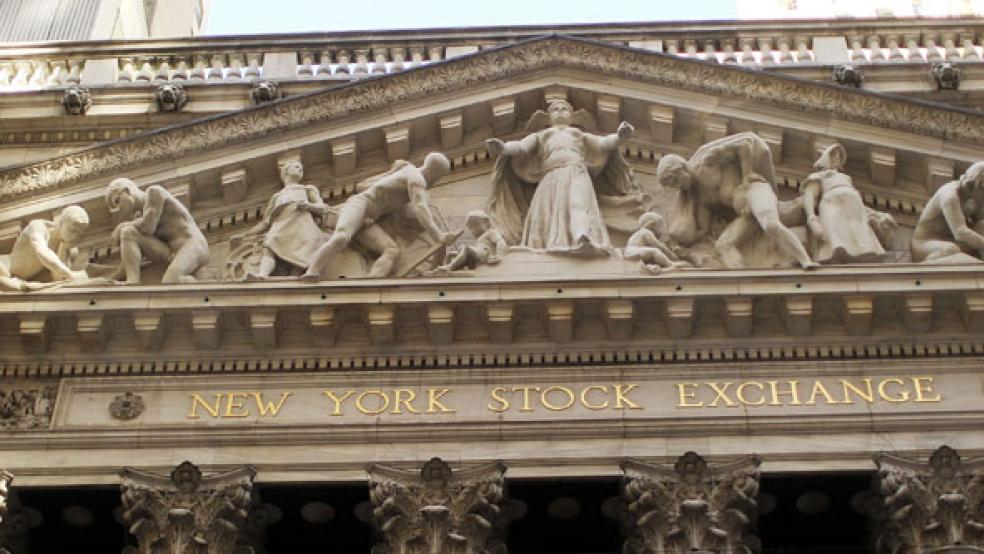Call it Wall Street’s version of the annual running of the bulls. For weeks, leading investment strategists have been busy issuing their stock market forecasts and targets for 2012. The predictions, not surprisingly, cover a fairly wide range, but the year-end targets for the Standard & Poor’s 500-stock index are largely bullish – also not surprising given the Wall Street set issuing them.
The S&P 500 finished 2011 almost exactly where it ended 2010, falling just 0.04 points, or 0.0028 percent, to 1,257. Looking 12 months out, the more bearish among Wall Street strategists have set a target for the S&P at or slightly below 1,250, though some have warned that the index could plummet more than 25 percent if the Euro collapses. But most analysts have set their targets for the index significantly higher, projecting gains of 6 percent, 8 percent, 12 percent or even 20 percent.
At the same time, their reports suggest it might not be easy getting there. The known risks are certainly plentiful. As Morgan Stanley’s Chief Investment Strategist David Darst noted in a market commentary earlier this month, “Significant factors that are likely to influence asset prices include: the health of the financial sector; house prices; jobs; consumer confidence; taxation and spending actions by the US Congress, the major credit-rating agencies; global currency relationships; fiscal austerity measures and sovereign-debt quality in Europe and elsewhere; geopolitics in North Africa and the Middle East; emerging markets’ and particularly the economic growth outlook in China, India, and Brazil; and the timing and composition of Federal Reserve monetary policy action.”
Whew. That’s a long list, and a familiar one – it’s precisely the same list of big questions and concerns we’ve been facing this year, suggesting a market environment in 2012 very similar to what we’ve already experienced. “Investors looking for a respite from this type of market may be disappointed,” Bank of America Merrill Lynch strategist Savita Subramanian wrote in her forecast for the year ahead, “as many of the same macro issues are likely to loom in 2012.”
That doesn’t even include what Donald Rumsfeld would have called known unknowns—like the results of the coming presidential and congressional elections —or unknown unknowns, those unexpected factors that could blindside the markets, like the earthquake and nuclear meltdown in Japan this year.
Yet despite all those uncertainties, the strategists cite a number of reasons to be upbeat about the economy and at least some areas of the stock market – with the degree of optimism depending on how long it takes to resolve the European debt crisis. And James Paulsen, chief investment strategist at Wells Capital Management, suggests that as we enter the third year after the Great Recession, sentiment might turn around and economic fears could abate:
“During both the 1991 and 2001 recoveries, ‘Year 3’ represented a ‘Gear Year’”—or a time “when cultural mindsets (among leaders, businesses, consumers, and investors) finally accepted the economic recovery was improving and was sustainable.” If that happens, companies could begin to invest and hire, Paulsen suggests, [setting the stage for stocks to rally].
On top of all that, the lingering uncertainties have tempered economic expectations, meaning that any upside surprises could provide an added boost for stocks. “After several years of disappointing economic performance, expectations for growth are currently very low,” writes Gary Thayer, chief macro strategist at Wells Fargo Advisors. “Therefore, investors are more likely to be surprised in 2012 by better economic performance than continued weak economic activity.”
Given that picture, a number of strategists are pointing their clients to a few key investing themes for 2012, including:
1. Growth
Corporate profits have reached record levels, but analysts expect growth to slow and have already begun trimming their estimates for 2012. In that environment, investors will be looking to buy those companies that are still delivering above-average year-over-year earnings increases. As Subramanian notes, “when profits growth is scarce, investors tend to pay up for stable earnings and tend to avoid companies with more volatile earnings.” With fears centered around Europe, some strategists recommend honing in on companies that derive more of their revenues domestically.
2. Quality
“High geopolitical and policy uncertainty and a stagnant economy favor stocks with safe balance sheets and stable growth,” Goldman Sachs strategist David Kostin wrote in a recent report (titled “Strategies for Stagnation”). For similar reasons, other investors are focused on large companies. “These companies usually represent lower risk than small-cap companies when global growth is slow,” writes Stuart Freeman, chief equity strategist at Wells Fargo Advisors, who forecasts that the S&P 500 will climb to between 1,325 and 1,375. “In addition, large- and mid-cap equities provide more liquidity than small-cap equities, which can help to moderate volatility.”
3. Dividends
Companies are flush with cash, which could drive merger and acquisition activity and be used to boost dividend payouts and share buybacks. Demographics may also drive interest in stocks that offer dividend payouts, as older investors look for more income from their portfolios. But analysts are not just focusing on companies with high yields, but also those whose payouts appear to be sustainable and growing.
When considering these or other analyst calls, bear in mind that predicting market moves is far from easy, even for the pros, and a broad consensus around these themes might be a sign that other bets will do better. There are few certainties, as Jim O’Neill, the chairman of Goldman Sachs Asset Management, noted in a year-end commentary. “One thing for sure we can say about 2012 is that there will be no shortage of things to think about,” O’Neill wrote, before adding a caveat that all investors should remember when reading predictions about the year ahead: “The only dilemma is that it is probably quite easy to get something(s) wrong!”





